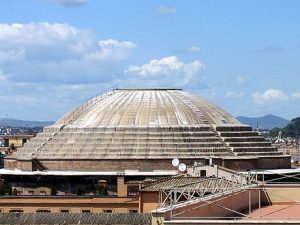After the fall of the Roman Empire in 476 A.D., the art of making cement was lost. It was 13 centuries later that John Smeaton pioneered the use of hydraulic concrete.

image source: https://en.wikipedia.org/wiki/Concrete#/media/File:Pantheon_dome.jpg

image source: https://search.creativecommons.org/photos/575e3c37-c199-4bbf-9862-30aabc271c7c
John Smeaton
The British engineer was commissioned by the parliament to rebuild the Eddystone Lighthouse situated off the coast of Cornwall, England. For this project, he started looking for a building material that would not be affected by any sorts of weather conditions.

image source: https://en.wikipedia.org/wiki/John_Smeaton#/media/File:John_Smeaton.jpg
He had carried out his research into various materials which could withstand the sea until he discovered a mix of lime, clay, and crushed slag from iron-making. This conglomerate could form a quick-drying material known as hydraulic concrete when using pebbles and powdered brick as aggregate. This is generally regarded as the first use of modern concrete in engineering.
Hydraulic lime
Hydraulic lime (HL) is a general term for the varieties of lime (calcium oxide) or putty lime (calcium hydroxide), used to produce lime mortars that harden by hydration. These contrast with the varieties of air lime, the other common types of lime mortar, which are fixed by carbonation (reabsorption of carbon dioxide (CO2) from the air).
Until the advent of artificial cement and especially Portland cement, lime was used almost exclusively. Although the term ‘hydraulic lime’ covers materials that vary in properties such as setting times and strength development, they all have common main characteristics:

image source: https://search.creativecommons.org/photos/548ecc84-baf4-4d7e-8009-87b553b520d9 by Chris Allen
- ability to drop underwater;
- great workability;
- low shrinkage;
- resistance to salt and frost;
- adequate compressive and flexural strengths;
Info sources:
https://www.britannica.com/biography/John-Smeaton#ref142747
https://en.wikipedia.org/wiki/Hydraulic_lime
